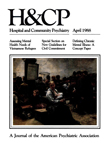Predicting Assaultiveness in Psychiatric Inpatients: A Pilot Study
Abstract
A sample of 87 psychiatric inpatients known to have been assaultive while in the hospital was contrasted with a matched group of nonviolent patients to identify the personal risk factors that distinguished the two groups. Data were collected using a personal history interview, a neurological examination, and an electroencephalogram. The four risk factors identified—neurological abnormality, history of violent crime, history of violent suicide attempts, and deviant family environment in childhood—were used to develop a statistical model predicting which subjects in a sample of newly admitted patients would become assaultive during the first three months after admission. The predicted classification of patients was found to be significantly related to subsequent assaultive behavior.
Access content
To read the fulltext, please use one of the options below to sign in or purchase access.- Personal login
- Institutional Login
- Sign in via OpenAthens
- Register for access
-
Please login/register if you wish to pair your device and check access availability.
Not a subscriber?
PsychiatryOnline subscription options offer access to the DSM-5 library, books, journals, CME, and patient resources. This all-in-one virtual library provides psychiatrists and mental health professionals with key resources for diagnosis, treatment, research, and professional development.
Need more help? PsychiatryOnline Customer Service may be reached by emailing [email protected] or by calling 800-368-5777 (in the U.S.) or 703-907-7322 (outside the U.S.).



